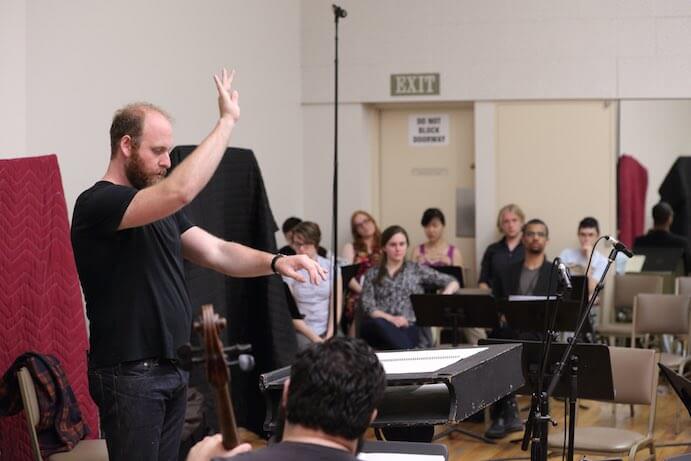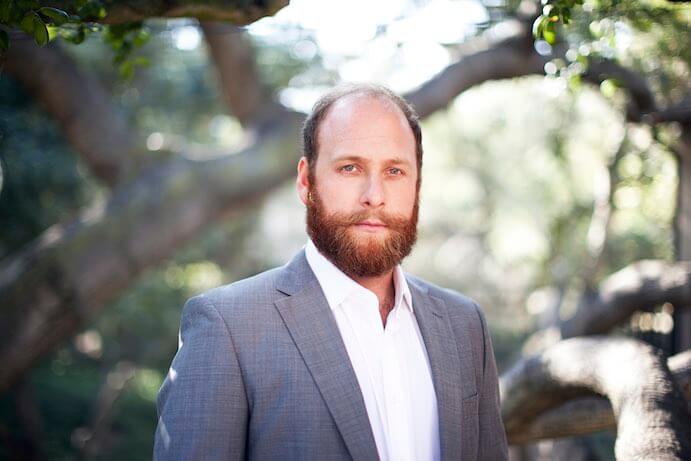wild Up is described in most reviews as a contemporary classical ensemble, but Artistic Director Christopher Rountree likes to refer to the group as “the band.” There is a certain inhibition regarding the stylistic universes that coexist in their programs and a great sense of each members’ fluid autonomy (as players, composers, improvisers … ), so much so that Rountree says he is simply the face of a much greater collective force which pulls him in many directions at once. A wild Up performance exists in an entangled equilibrium which oscillates between extroverted comedic absurdity and the introverted realms of serious contemplation. On September 11, 2015 at the Roy and Edna Disney/CalArts Theater (REDCAT), American Composer’s Forum (ACF) and wild Up will present three premieres by the winners of this year’s ACF National Composition Contest, and continue striking uncharted paths for new music in Los Angeles and beyond.
Describe this year’s acf winners and why they resonate in an era of post/hyper/poly/eclectic musical approaches? Why this music?
The pieces we ended up with and the composers we ended up with are incredibly diverse. There’s a bunch of Parametric Music, but two of the pieces really live in the realm of ideas more than in the realm of sound. Alex Temple’s piece is about Frank Zappa, it’s called “The Man Who Hated Everything.” It has crooner singing, yelling, and at one point or another each member of the band becomes a vocalist, or a storyteller, or both. We have one piece that is like Alex’s, and then another like William Gardiner’s which is a whole lot more austere. It’s really about sounds, but it looks gorgeous. The intentionality and the way that his score is made is so specific; you look at it and you’re like, “This. This is a thing of beauty.”
When you see a new score for the first time, as a conductor (and as a composer) what are the elements/details of that score that speak to you? What makes a score interesting?
We all meet music in different ways. Visually is only one of the ways. I think very often you hear someone’s music and then you’re like, “Oh Wow! I wonder what that looks like?” It’s seldom that we have it the other way around; where you see the music and then go, “This is such a thing of beauty, I have to learn this … we have to do this.” Of the ACF composers, the only one that we’ve encountered previously is Nina C. Young. After the competition’s blind selection process had ended, there was this work of hers, “Traced Upon Cinders,” which we decided to program, and I remember that piece’s incredible level of detail. When you look at music closely enough, every single detail is like watching someone make a choice. In some scores, you look at them and they look arbitrary. It’s hard when you look at minimalism (which we play a ton of and totally love). There’s so much minimalism that looks arbitrary. You look at the score and its mysteries are not present visually. Its true identity is revealed only when you’re in the room with it, and then it becomes itself. In Nina’s piece, there is so much detail in the score, and it almost … and what it is: it’s ostensibly a drone piece! There are these big/huge/beautiful figures, these lines that together create only *one-sound.* But there’s so much detail in the score that a listener might miss it aurally, it’s hidden. If you said to someone, “listen and match the score with this piece,” they might match it to a piece that looked like whole notes. The main word in finding something that speaks to me is: intentionality, and then from there how someone makes that intentionality visible.

Christopher Rountree and wild UP– Photo by Craig T. Mathew
Photo by: Craig T. Mathew/Mathew Imaging
wild Up Is known for presenting music stylistically described as the new-complexity, and indeed you seem to favor placing audiences in complex, strange, maybe volatile situations and unusual venues. Tell us why this is so exciting to do now and secondly, a little bit about locative music’s potentialities.
This is what complex music does to us: if you are being propelled through music at a breakneck pace, a pace like you’ve never seen before, and there are so many new things hitting you over and over in the face along the way; there’s something that happens to one’s brain, to one’s mind in that situation. And usually what happens for me: is that I start to laugh. So once all the complexity hits me, and the cup is full and starts pouring water out over the top of my head: then I start laughing. I’ve always felt like that’s the way new music is; I am overwhelmed by it, and then I kind of fall in love with it through being overwhelmed by it. Our hope is that complexity (all types of complexity), given the correct context, given powerful contextual work, really considered contextual work, can do that for people. Our hope is that we can create the ‘overwhelm-into-bliss’ moment for people.
Tell us about wild up and how it adheres (or doesn’t) to a particularly west-coast sensibility (frontierism, exploratory attitudes, separation from establishment music culture).
So I think there’s this question of the butterfly effect. The “which-one-created-the-other” thing. Um, I’ll explain this in a second but: Sousa is a West Coast thing. And the genius and the comedy that are allowed in a space like Sousa’s space: they’re pretty amazing. Hopefully in wild Up we have as much comedy as we can, and that’s brand new for new music. People have been doing it, but the fact that we are actually allowed to keep doing it, and that it has become such a central part of our practice … that’s something I feel fortunate about. When we started-out here in LA, there wasn’t something like us. And I think there are more and more things like wild Up appearing. The fact that there’s a groundswell in Los Angeles, it’s fantastic. The fact that there is a community that’s burgeoning, that has surface tension and is bursting: it’s great. It seems like the space out-here on the west coast actually created the necessity for us to be here and the means for us to be here. So then maybe the space itself, the west coast itself, is actually the egg. But we didn’t know that before the band appeared. Everything we’ve done, was done by accident. Once we made a mistake that worked, where we were (unknowingly maybe) intentional about cultivating that space, we tried our damnedest to hold on to that. The second concert we ever did, my friend Paul said: “Man, you program just like John Philip Sousa.” ‘What?!’ “Oh. Well … in John Philip Sousa’s band, they did new music by people in the ensemble. They did theater music that was often funny. They did classical music re-imagined, that had been taken apart and put back together. They did vernacular music, they did pop music arranged for the band. And they did all of this, kind of—all together—under the same roof. All of this was new music. Once Paul codified the programming technique by saying that to me, I was like, “Oh, is that really what we’re doing? Well, we’ve done that a couple times! Does it work? It seems like it’s working! Let’s try it a couple more times.”
What sort of spaces and roles do you see ensembles like wild up and other chamber groups and orchestras playing in 5-10 years from now?
Part of our practice is workshopping what the future of the thing will be, and then actively creating what the future of the thing will be. That’s what we all aspire to. And, I think, we aspire to make things that are more relevant, more powerful, and reach more people. Works that do something powerful for classical music, that connect it to each one of us and in so doing make it relevant. We want to take the lineage of classical music, in everything that it is, and make its power more transparent. We want to make our access to classical music more simple and immediate. The goal is to make things that are really meaningful, and to maybe make a little less than we are making right now; less concerts—more specific, more powerful. We want to empower each one of our members to create the things that they want to create — the pieces that are at their core. We want to work all over the world, with warm people, and aim for an audience that is made up of absolutely everyone that likes beautiful things. Everyone that likes challenging things.





















